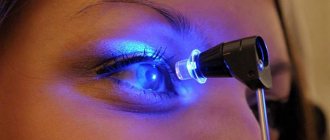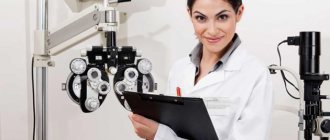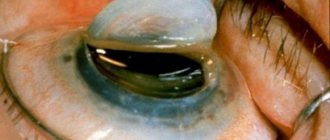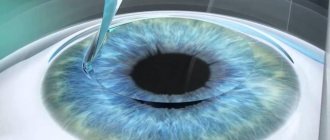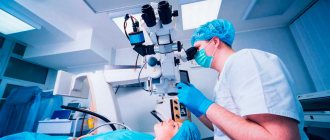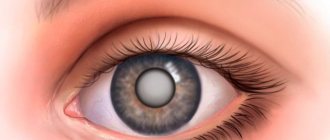Laser vision correction is an operation that can be used to restore the functionality of the eyeballs with myopia, hypermetropia, and astigmatism. It is associated with certain side effects that may be common in all patients or may be complications.
To eliminate them, you must adhere to the rules of the rehabilitation period and promptly contact an ophthalmologist. Self-medication is unacceptable; it will lead to decreased visual acuity and possible blindness.
Side effects after surgery
There are side effects that occur in all patients. They are normal because an incision was made on the cornea. This is associated with the appearance of certain symptoms:
- Hemorrhages in the cornea. They are observed in the patient in the first week after surgery. They can be either minor or extensive. It depends on the chosen technique and the structure of the human eyeball. The hemorrhage resolves on its own and does not require the use of drugs.
- Decreased visual acuity. This effect can be observed immediately after the operation. It does not occur in all patients. The symptom is determined in people who have chosen the correction method using Lasik technology. Patients who choose Femto Lasik technology limit themselves from such complications, since the incision on the cornea is minimal. The flap is thin and smooth, so it fuses with the tissue faster.
- Pain. It appears in all patients after the anesthetic effect of the drug has passed. This is due to the fact that an incision was made on the cornea. The tissues of the eyeball quickly grow together, so this effect is eliminated within a few hours. Cases have been recorded where pain, itching, and burning lasted up to 2 days.
- Increased photosensitivity. Doctors warn that immediately after the operation it is necessary to wear sunglasses when the person leaves the clinic outside. In the future, it is recommended to wear sunglasses for about 1 week until photophobia disappears. On the first day, it is recommended to spend the day in a dark room, preferably sleeping longer.
- Dry eyes. During an incision in the cornea, the integrity of the eyeball is disrupted so that its contents do not leak out; the ophthalmologist uses a vacuum. This technology damages the corneal cells that produce and retain tear fluid. Therefore, increased eye dryness is observed within 1-2 weeks. To eliminate it, doctors prescribe moisturizing drops. Their positive side is that they can be used as needed and are not addictive.
To eliminate these effects, you must adhere to the rehabilitation recommendations prescribed by your doctor. The duration depends on the chosen technique. If it is Lasik, rehabilitation lasts up to 2 months. When choosing Femto Lasik, the time is reduced to 2-3 weeks.
What is laser eye surgery?
Laser vision correction is a high-precision method of treating eye diseases. The procedure helps restore the brightness and contrast of the visible image, eliminating the need to wear glasses and contact lenses. Eye surgeries using lasers began to be performed 30 years ago under the leadership of Svyatoslav Fedorov. Laser correction refers to minimally invasive methods of treating visual acuity.
With any type of visual impairment, the image is incorrectly focused on the retina. Therefore, the main principle of laser surgery is to change the shape of the cornea so that the refracted beam of light precisely hits the retina. To do this, surgeons use a laser to vaporize a thin layer of epithelial cells on the cornea.
To perform the operation, the patient must undergo an ophthalmological examination so that doctors receive complete information about the condition of his visual organs. Thanks to laser correction, myopia, astigmatism and hypermetropia can be treated in patients aged 21 to 55 years.
How is it done?
Before the operation begins, the ophthalmologist directs the patient to a number of examinations:
- donating blood for general analysis;
- exclusion of hepatitis B and C, HIV infection;
- ophthalmoscopy;
- slit lamp examination;
- MRI, angiography, radiography using contrast and other examinations depending on the type and severity of the disease, the condition of the tissues of the eyeballs.
IMPORTANT. In preparation for the procedure, the patient should stop wearing contact lenses: soft 1 week before surgery, hard ones 14 days before surgery. You should avoid using alcohol 48 hours before laser correction. On the eve of the operation, it is prohibited to use cosmetics.
The procedure is carried out using a special device that directs a laser beam onto the cornea. Heat waves evaporate thin layers of cells. Despite the use of high-tech techniques, the microsurgical operation takes no more than 15-30 minutes.
Expert opinion
Nosova Yulia Vladimirovna
Ophthalmologist of the highest category. Candidate of Medical Sciences.
Treatment is carried out on an outpatient basis. After receiving the examination results and making an accurate diagnosis, the patient lies down on a couch or a special chair. The doctor instills anesthetic into the eyes for pain relief and fixes the patient’s head. After this, the eyelids of the affected eye must be secured in the open position.
Using a keratome, the surgeon uses a microtome to cut a small section of the cornea and retract it to the side, leaving part of the flap attached to the anterior chamber of the eye. This is necessary to gain access to the deeper layers of the cornea.
The transparent fabric is then exposed to laser light, giving it a new shape. After completing the manipulations, the doctor returns the allocated area of the cornea to its original position and smoothes it over the surface of the eyeball.
To reduce the risk of infection, antibiotic drops are instilled into the operated area. Doctors remove the clamps from the eyelids and head. The patient can go home.
When the eyeball moves during surgery, there is no threat to vision. A scanner on the hardware unit registers the slightest deviations in gaze and corrects the direction of the laser beam. If there is a sudden and strong deviation of the eye, the device automatically stops working.
The most common complications after laser vision correction
Currently, the most modern devices are used for vision restoration and correction. This significantly reduces the risk of complications. But in some categories of patients they still appear. This is due to the health of the eyeballs, the quality of rehabilitation, and the qualifications of the ophthalmologist.
Corneal opacity
During the operation, an incision is made in the cornea. If you use modern technologies based on Femto Lasik, you get an even, thin and smooth layer. Next, a vacuum is connected to the patient's eye to prevent the contents of the eye from leaking out. It is these 2 actions that lead to an increased risk of corneal clouding. Because of this, the patient’s vision decreases and the refractive ability of the eye is impaired.
Astigmatism
The eyeball is an integral structure. It has a certain shape, so the light beam is refracted in the cornea and lens and projected on the retina. If its structure has been damaged, the eye may lose its normal shape. In this regard, astigmatism appears.
This means that after refraction, the beam is projected not at the center of the cornea, but at two points:
- on the cornea;
- in front of or behind the cornea.
Because of this, the perception of the environment changes. A person can determine the shape of objects incorrectly. Additionally, visual acuity may decrease.
Double vision
The vision defect occurs because each eye recovers differently. The retina contains rods and cones. To capture the shape and color of an object, the same nerve endings must be activated. If the refractive power changes in only one eye, information is not transmitted correctly to the brain. This causes double vision.
Decreased visual acuity
If the cornea heals improperly, the refractive ability decreases sharply. The light beam is refracted incorrectly, so it is projected in front of or behind the cornea. Therefore, the patient's visual acuity drops sharply. Myopia or hypermetropia may develop. In this case, you will need to wear corrective lenses or glasses, and repeat surgery by a qualified surgeon.
Infection
Before the procedure and immediately after its completion, the patient is prescribed antibacterial drops.
If a person does not use them, their effect is insufficient, and infection may form. Since an incision was made on the cornea, the risk of pathogenic bacteria entering the eyeball increases. This will cause internal suppuration, and the patient may completely lose vision function.
Light halos
If during the procedure there was damage or clouding of the cornea, lens, or vitreous body, the patient may continue to see light halos, spots, dots, and lightning before the eyes. A halo effect may occur. This is a state in which the glow from objects expands to its maximum extent. For example, when a person is driving a car at night, the glow from the lights will completely block the road.
What can go wrong after laser vision correction and how to avoid negative consequences
We know why you are here. You came to be afraid.
In fact, what people fear most is the unknown - that's why we talk here about everything related to laser vision correction. So you can weigh the pros and cons and make a decision with all the cards in your hand.
So, today we’ll talk about what can go wrong after laser correction.
Consequences of laser vision correction: return of myopia
It’s not scary if your vision deteriorates a little - you can always make additional correction.
The most important consequence after laser correction is that myopia may return. Why is this happening? There are two main reasons:
- Staying in the sun without sunglasses.
- In women in the postpartum period - since during the pushing period the membranes of the eye may weaken, and the eye may enlarge by fractions of millimeters, then myopia will return.
In both cases, if the thickness of the cornea allows, additional correction can be made.
Here we need to make a small digression and talk about the thickness of the cornea. The cornea is usually half a millimeter thick. There is a so-called residual value - that is, a margin beyond which the laser cannot evaporate the cornea during surgery. This thickness is calculated automatically, it is built into the laser and taken into account by surgeons. If the depth of evaporation to be produced by the laser shows that the residual value is less than normal, the laser will not allow the procedure to be completed.
Roughly speaking, no one will cut off more from the cornea than necessary, even during additional correction.
Another possible consequence of laser correction is retinal thinning
Nearsightedness (myopia) is a condition in which the eye is enlarged in size. Normally, the eye is about 23 mm; in nearsighted people it is longer. This affects the retina - it becomes thinner at the places where it is attached. Regardless of whether the patient undergoes surgery or not, he needs to undergo an annual examination of the fundus - that is, the periphery of the retina. Before correction, this examination is also carried out as part of a comprehensive diagnosis.
At the slightest sign of deterioration, surgeons recommend strengthening the retina. What could go wrong if you don't do this? Retinal detachment may begin. And this can lead to loss of vision.
How to avoid this? Undergo regular examinations by doctors, and for people with myopia, additionally undergo a fundus examination.
Side effects after laser correction or the effect of new vision?
Many people worry about night vision after surgery. Indeed, many experience a halo effect - this is the effect of light scattering due to the fact that light is refracted in different ways.
At night, a halo effect may appear. But modern technology will help fix this.
How does this happen:
The pupil dilates in the dark, allowing more light to enter. If the cornea diameter is 12 mm, laser evaporation occurs in the so-called optical zone, and its diameter is 9 mm. That is, light refraction may appear at the border of the operated and non-operated area, so vision may deteriorate at night, and a halo appears.
How is this leveled out? Modern technologies. Previously, in the late 90s - early 2000s, the laser exposure zone was 6 mm. Now this figure is no less than 8.5. Lasers continue to be improved to minimize these effects.
How different techniques affect the side effects of laser correction
The cornea has the shape of a sphere. It is necessary to create a corneal flap with a laser, a kind of lid that bends and opens access to the cornea. You can form it in different ways. In the standard LASIK procedure, the flap is created using a microkeratome. It does not perfectly follow the spherical shape of the cornea.
The microkeratome is placed on the eye, the cornea is slightly flattened, and the microkeratome cuts it off. As a result, the flap turns out to be slightly uneven; these unevennesses are measured in microns. And the more modern femtosecond laser perfectly follows the rounded shape of the cornea, and this reduces the effects of night vision deterioration.
Complications after LASIK vision correction
The most serious complication is induced keratoconus. This is a progressive thinning of the cornea. This is due to the fact that for certain reasons the cornea protrudes, and its frame begins to thin.
The good news is that keratoconus can now be predicted. At each examination, screening is performed to exclude keratoconus, which may not be acquired, but genetically determined. In this case, unfortunately, laser vision correction cannot be done due to possible consequences.
How to avoid consequences and complications after laser vision correction
- Immediately after surgery - avoid an inflammatory reaction. After the operation, the flap is very well fused to the cornea, but impacts and injuries to the eye must be avoided. And wear sunglasses.
- During the first three months , there may be dry eye syndrome, since during the operation the nerve fibers and tear film evaporate, after which they gradually begin to recover. And since there are no connections yet, a person may not feel enough that the eye is drying, so it is better to protect them from dust and try not to catch a cold. A mandatory requirement is to instill tear substitutes without preservatives.
If you have any doubts or questions, sign up for a consultation! We will discuss, tell and advise.
Rare complications
Some categories of patients experience rather rare complications. They occur in the smallest percentage of cases. Therefore, it is important to choose a qualified surgeon. To eliminate them, you will need repeated surgery and long-term drug treatment.
Hemorrhage inside the eyeball
If a patient has a pathology of eye microcirculation, the risk of intraocular hemorrhage increases. It can be minimal, then it will resolve itself. If it is significant, additional surgical intervention and the use of medications that promote blood resorption will be required.
Displacement of the corneal flap
Immediately after surgery, the corneal flap can heal for quite a long time. If the patient touches the eye, there will be an impact or injury, and the flap may become dislodged. This is extremely dangerous, as an infection will get inside the eyeball. It is necessary to immediately contact a surgeon to restore the integrity of the eye.
Keratoconus
After laser vision correction, it is possible to change the shape of the eyeball. The cornea is sharply drawn forward, so the layer becomes thinner. A dangerous complication of keratoconus is extreme thinning, leading to rupture of the cornea. That is, the structure of the eyeball will be disrupted, and the patient will lose vision function.
Dry eye syndrome
There are cases when dry eyes due to damage to the corneal epithelium do not go away. This condition remains with the patient for life. He will be forced to apply moisturizing drops every few hours to prevent microtraumas and cracks from forming on the cornea.
Deterioration of vision at dusk
On the retina of the eyes there are rods that perceive surrounding objects in twilight or darkness. If this area is damaged during the procedure, the person will lose twilight vision, and the so-called state of “night blindness” will occur. It is impossible to eliminate this shortcoming.
Expert advice
Correcting the consequences of laser vision correction
Dark Affairs
It is important to understand that laser vision correction is a medical operation, which, like any intervention in the body, can lead to malfunctions in its functioning. The procedure corrects vision by changing the cornea: that is, the same myopia de facto does not disappear anywhere, but becomes invisible to the patient. But the cornea, weakened after surgery, can react to any emergency situation - from the onset of a disease to changes in hormonal levels, resulting in undesirable effects. One of the most common among them is twilight vision impairment. It manifests itself in the dark: in the blurring of luminous objects into a blot, a blurry picture, the appearance of light halos or double vision.
To be fair, it should be noted that such consequences do not always arise. It all depends on the initial data of the patient himself, for example, the size of the pupil. What does the pupil have to do with it? It's simple: in most cases, the laser affects only the central part of the pupil, but does not affect its periphery. And if during the day, when there is a lot of light, this does not in any way affect the clarity of the image, but in low light conditions the pupil dilates and the picture begins to float.
In addition, if before the operation there were significant visual defects - for example, fairly high myopia, then after laser correction the patient is likely to encounter side effects. Of course, all this is unpleasant, but not critical - unless you are an avid car enthusiast. In this case, the decrease in night and evening vision becomes a big problem, especially in winter, when independent car movements have to be completed before it starts to get dark, that is, before 16-17 hours.
I want to see in the dark!
In low-light conditions, motorists have to subject themselves to various – often risky – tests: eye strain, misjudging the distance from other cars, and being blinded by the bright lights of oncoming cars. The latter is especially dangerous because the eye adapts to darkness slowly. Having suddenly lost the ability to see due to a bright flash, a person remains disoriented for several minutes until the eye again gets used to the unnatural conditions.
How to protect yourself on the road? One of the common solutions to the problem is special coatings for spectacle lenses - for example, anti-reflective coatings. They reduce reflection from the surfaces of lenses and increase their light transmission: and the more light the eye reads, the sharper and clearer the picture becomes. In addition, coatings allow the eye to relax, which also affects the quality of vision.
Another popular, but not ideal, option is to wear glasses with colored, yellow-orange lenses. They do improve the clarity of vision by reducing the color variation of the entire picture, but are inconvenient at night because they reduce the flow of light entering the eye. There is one more disadvantage - the driver may have the feeling that he sees objects at a greater distance than they actually are due to the increase in contrast. And for older people, whose pupil itself allows little light to pass through, yellow glasses will become a non-functional and sometimes dangerous solution.
Modern advanced optics offer another method - special individual spectacle lenses for improving vision in the twilight, which appeared on the market relatively recently. They improve the sharpness, contrast and clarity of vision in bright light, but have the greatest effect in poor lighting. Individual lenses at each point reflect the unevenness of the eye, which ultimately helps to see, if not ideally, but close to this indicator. True, there are also disadvantages: a fairly high cost, as well as the need for high qualifications and special equipment to create the correct prescription for such glasses.
Everyone come out of the darkness!
Individual lenses are often compared to a tailored suit - they fit flawlessly. They reflect all the features of vision and ultimately correct every imperfection of a particular person’s eye, or, in medical terms, an aberration. The problem is that the types of these aberrations, as well as their quantity, are different for everyone, and therefore it is necessary not only to measure them correctly, but also to take them into account in the spectacle lens. It is simply impossible to obtain such lenses right away - you must first take measurements and then wait for the work to be completed. The most important point in this process is diagnosis, because if the parameters of the eye are determined incorrectly, then individual lenses, instead of a super-technological and high-quality solution, will turn out to be another pair of glasses with which something is wrong.
A quick and ergonomic solution was proposed by the German company Carl Zeiss Vision, which presented the i.Profiler device, unique in its complexity. This is a wavefront aberrometer, or, in more understandable terms, a device that measures individual distortions of the eye. It combines the capabilities of an entire optical laboratory and determines all visual defects, that is, those very notorious aberrations on which the quality of vision depends. Moreover, i.Profiler can track changes that occur in the eye in various situations - in particular, in low light conditions. This precision is achieved through the use of a unique method previously used in astronomy: i.Profiler sends soft infrared rays into the eye - at 1,500 individual points, and then analyzes their reflection. This entire analysis takes place in just 30 seconds, after which the optometrist - the specialist who works behind the device - gets a complete picture of the patient's vision.
But how does this discovery help in selecting glasses? It's all about one of the functions of the device, namely the i.Scription method. It allows you to take into account high-order aberrations of the eye when calculating and creating lenses for glasses. This is where the trick lies - the collected information helps to produce glasses with ideal optical power, and therefore dramatically improve the quality of vision. After diagnosing the patient, data from the i.Profiler device about the characteristics of his eyes is sent directly to the Carl Zeiss plant, where lenses are created that take into account all the characteristics. The numbers speak for themselves: 74% of eyewear users using i.Scription technology report better night vision and improved contrast. Is it any wonder: the lens is created as individual as a fingerprint. Samara became the first Russian city where the i.Profiler aberrometer appeared. It is in the “Luxury Vision” salon, located on Samarskaya, 131, that everyone can still undergo, perhaps, the highest quality automatic eye diagnostics in the world.
How to minimize the risk of complications after laser vision correction
To reduce the risk of complications, it is recommended to adhere to the following rules:
- visit an ophthalmologist 3 times after surgery on the appointed days;
- use anti-inflammatory, moisturizing, antibacterial drops and other medications prescribed by your doctor;
- use well-tinted sunglasses;
- do not touch the eyeballs, avoid injuries and mechanical damage;
- give up sports and any physical activity for a while;
- do not drink alcohol;
- reduce the amount of time spent at the computer, TV, phone, tablet;
- Avoid visiting bathhouses, saunas, and sunbathing in the open sun for 1-2 months.
Using all the rules does not mean that complications will not occur. There is a certain risk of their occurrence.
Patient reviews
Mikhail, 32 years old: I recently had laser correction using the Femto Lasik method. Vision was restored instantly, but after the operation my eyes hurt badly. The mucous membrane dried out for 1 month and moisturizing drops were used. But over time, the side effects completely disappeared.
Elena, 25 years old: Two years ago I had my vision restored using the Lasik method. After the procedure there were severe hemorrhages on the cornea. The doctor prescribed medications, I used them for quite a long time. But there was still bleeding inside the eyeball. I had a second operation. After this, vision was restored. But it was very difficult.
Alexander, 28 years old: The doctor advised me to restore my vision. I chose the Femto Lasik procedure because I was told there were no complications after it. And so it happened, my eyes hurt very much on the day of the procedure, there were small bruises on the cornea, but all the symptoms quickly went away. Now I see very well.
Author's rating
Author of the article
Alexandrova O.M.
Articles written
2031
about the author
Was the article helpful?
Rate the material on a five-point scale!
If you have any questions or want to share your opinion or experience, write a comment below.



